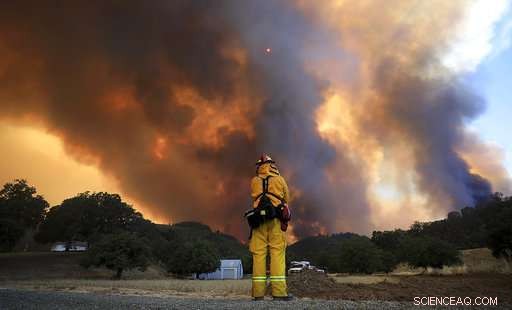
Neste 2 de agosto, 2018, foto do arquivo, uma torre de fumaça emana de Cow Mountain como Burney, Califórnia, o bombeiro Bob May vigia a vegetação circundante em busca de focos de incêndio durante o incêndio no rio perto de Lakeport, Na Califórnia, os incêndios florestais que há muito moldam a paisagem do oeste dos EUA estão ficando maiores e queimando por mais tempo - trazendo mais fumaça sufocante, deslizamentos de lama mortais e perda de habitat. (Kent Porter / The Press Democrat via AP, Arquivo)
Incêndios florestais nos EUA queimaram mais de 10, 000 milhas quadradas até agora este ano, uma área maior que o estado de Maryland, com grandes incêndios ainda queimando em todos os estados ocidentais, incluindo muitos que não estão totalmente contidos.
Seja desencadeado por raios ou humanos, o fogo tem sido uma força que molda a paisagem do oeste dos EUA.
Quente, os ventos secos podem transformar as chamas em tempestades de fogo que deixam para trás terrenos baldios carbonizados, sujeitos à erosão e deslizamentos de terra. Outros incêndios eliminam a vegetação rasteira, abra o chão da floresta à luz do sol e estimule o crescimento.
As agências governamentais nas últimas décadas efetivamente alteraram esse ciclo de destruição e renascimento. As políticas de supressão de incêndios permitiram que os combustíveis se acumulassem em muitas florestas ocidentais, tornando-os mais suscetíveis a grandes incêndios.
Essas influências são ampliadas à medida que o desenvolvimento se arrasta cada vez mais para as florestas e a mudança climática aumenta as temperaturas. Imagens recentes de subdivisões em chamas colocam o poder e o papel ecológico dos incêndios florestais em destaque.
Uma olhada nos efeitos ambientais dos incêndios florestais:
FUMO E RUÍNA
Quase imediatamente, o fogo traz destruição.
As temperaturas de incêndios extremos podem chegar a 2, 000 graus Fahrenheit - quente o suficiente para matar todas as plantas, incinere as sementes escondidas sob a superfície e asse o solo até que se torne impermeável à chuva.
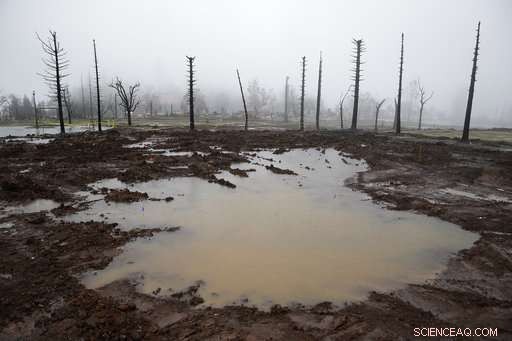
Em 8 de janeiro, 2018, foto de arquivo mostra poças de água da chuva onde uma casa no bairro de Fountaingrove ficava em Santa Rosa, Na Califórnia, os incêndios florestais que há muito moldam a paisagem do oeste dos EUA estão ficando maiores e queimando por mais tempo - trazendo mais fumaça sufocante, deslizamentos de lama mortais e perda de habitat. Seja desencadeado por raios ou humanos, o fogo tem sido uma força que molda a paisagem do oeste dos EUA. (AP Photo / Eric Risberg, Arquivo)
A paisagem sem vida torna-se sujeita a erosão severa, sujando córregos e rios com lodo que mata peixes e outras formas de vida aquática. Torrentes de detritos lamacentos após incêndios no ano passado no sul da Califórnia mataram 21 pessoas e destruíram 129 casas.
Cientistas do U.S. Geological Survey dizem que o problema está piorando à medida que a área queimada anualmente por incêndios florestais aumenta. Um estudo no ano passado concluiu que os sedimentos da erosão após os incêndios mais do que dobrariam em 2050 para cerca de um terço das bacias hidrográficas ocidentais.
A fumaça dos incêndios florestais no oeste deste verão - um perigo potencial para a saúde de indivíduos em risco - levou ao fechamento do Parque Nacional de Yosemite por mais de duas semanas e foi levado para a Costa Leste, de acordo com a NASA. Pesquisas recentes afirmam que isso também impacta a mudança climática à medida que pequenas partículas espiralam para a atmosfera superior e interferem nos raios solares.
PERGUNTAS CLIMÁTICAS
Os cientistas concordam amplamente que os incêndios florestais estão ficando maiores na América do Norte e em outras partes do mundo à medida que o clima esquenta. Mas ainda está emergindo como essa mudança irá alterar a progressão natural do fogo e da regeneração.
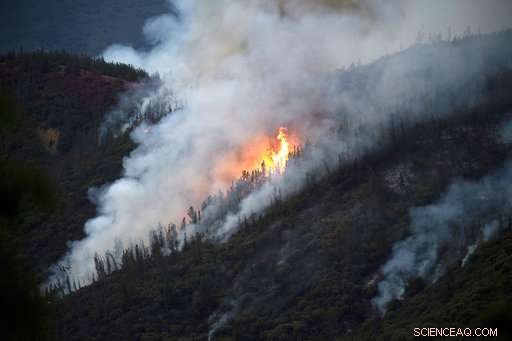
Neste domingo, 15 de julho 2018, foto do arquivo, as chamas do incêndio em Ferguson queimam uma encosta no condado não incorporado de Mariposa, Califórnia, perto do Parque Nacional de Yosemite. Incêndios florestais nos EUA queimaram mais de 10, 000 milhas quadradas até agora este ano, uma área maior que o estado de Maryland, com grandes incêndios ainda queimando em todos os estados ocidentais, incluindo muitos que não estão totalmente contidos. Quente, os ventos secos podem transformar as chamas em tempestades de fogo que deixam para trás terrenos baldios carbonizados, sujeitos à erosão e deslizamentos de terra. (AP Photo / Noah Berger, Arquivo)
The time interval between wildfires in some locations is getting shorter, even as there's less moisture to help trees regrow. That means some forests burn, then never grow back, converting instead into shrub land more adapted to frequent fire, said Jonathan Thompson, a senior ecologist at Harvard University.
"They get stuck in this trap of repeated, high-severity fire, " Thompson said. "Through time we'll see the California shrub land shifting north."
Similar shifts are being observed in Colorado, Wyoming's Yellowstone National Park and Glacier National Park in Montana, ele disse.
The relationship between climate and fire cuts both ways. A longer fire season and bigger fires in the boreal forests of Alaska and Canada are burning not just trees but also tundra and organic matter in soils, which hold roughly a third of the Earth's terrestrial carbon, said David Peterson, a former U.S. Forest Service research scientist.
The carbon enters the atmosphere and contributes to higher temperatures, leading to bigger fires that release yet more carbon.
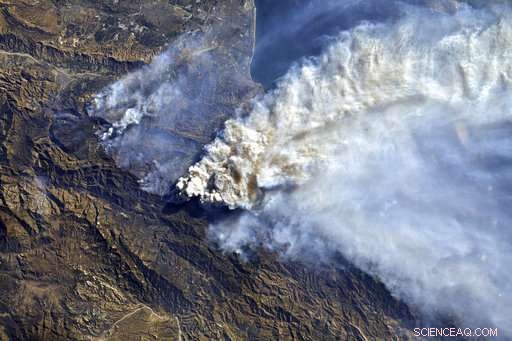
This Dec. 7, 2017 photo by NASA astronaut Randy Bresnik from the International Space Station shows smoke from California wildfires. Wildfires in the U.S. have charred more than 10, 000 square miles so far this year, an area larger than the state of Maryland, with large fires still burning in every Western state including many that are not fully contained. Whether sparked by lightning or humans, fire has long been a force shaping the landscape of the U.S. West. (Randy Bresnik/NASA via AP)
BIRD IN THE BALANCE
Life and property still top the list of priorities for firefighters, but in recent years another asset has been deemed worth extra protection in many Western states:a chicken-sized bird known as the greater sage grouse.
Fires burned an estimated 3, 240 square miles (8, 390 square kilometers) of the bird's sage bush habitat in 2017 and have burned almost 2, 400 square miles (6, 215 square kilometers) so far in 2018.
When sage brush burns, it's often replaced with a plant from Europe called cheatgrass, which crowds out native plants and is more prone to burning.
That's challenging government efforts to keep greater sage grouse off the endangered species list, which could restrict economic development.
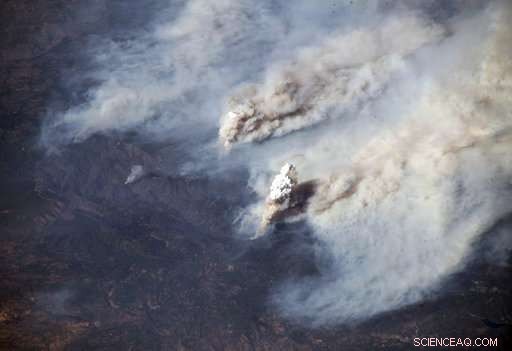
This Aug. 3, 2018, photo by European Space Agency astronaut Alexander Gerst aboard the International Space Station, provided by NASA, shows smoke from California's Carr and Ferguson fires blowing eastward across the western United States. Wildfires in the U.S. have charred more than 10, 000 square miles so far this year, an area larger than the state of Maryland, with large fires still burning in every Western state including many that are not fully contained. Whether sparked by lightning or humans, fire has long been a force shaping the landscape of the U.S. West. (Alexander Gerst/ESA/NASA via AP)
Areas considered crucial to the bird's survival now get extra attention:A military-type Blackhawk helicopter is under government contract to deploy quick-reaction teams to snuff out sage brush fires in portions of Idaho, Nevada, Utah and Oregon.
REGENERATION
A turning point in public understanding of the ecological importance of fire came in 1988 , when 1, 240 square miles (3, 200 square kilometers) of Yellowstone National Park burned.
The devastation, punctuated by images of wildlife fleeing flames, fed into the perception of wildfires as a menace to be battled.
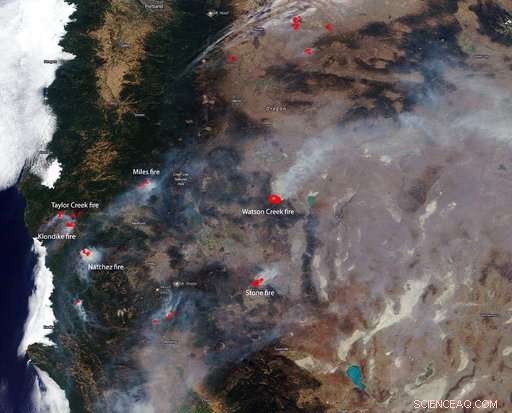
This NASA satellite image posted Aug. 20, 2018 shows several of the larger wildfires in both Oregon, principal, and California. Wildfires in the U.S. have charred more than 10, 000 square miles so far this year, an area larger than the state of Maryland, with large fires still burning in every Western state including many that are not fully contained. Whether sparked by lightning or humans, fire has long been a force shaping the landscape of the U.S. West. (NASA via AP)
The events drew criticism of the park's "let it burn" policy. Officials didn't immediately squelch lightning-caused fires that June because they did not pose an immediate threat to life or property, but eventually ended up deploying 10, 000 firefighters.
By that fall, seedlings already were emerging in some burned out areas. Park biologist Roy Renkin recalls a visitor reacting with surprise a decade later when he told her a thick stand of young trees emerging from a burned area had come back on their own.
Lodgepole pines are commonly cited as an example of forest resiliency. The fire's heat releases seeds from the pine's cones.
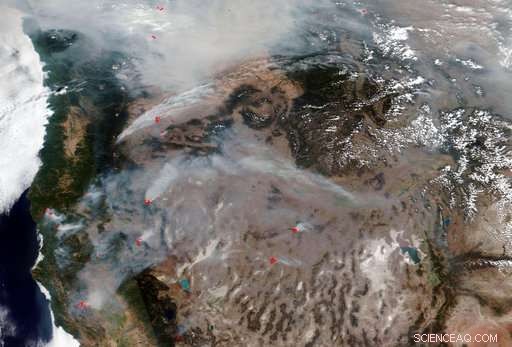
This image posted by the National Oceanic and Atmospheric Administration (NOAA), released by NASA, on Aug. 20, 2018, shows Western states, California at left, shrouded in smoke from the more than 100 large fires, including smaller fires within each complex of fires, that have erupted across the region during this fire season. Wildfires in the U.S. have charred more than 10, 000 square miles so far this year, an area larger than the state of Maryland, with large fires still burning in every Western state including many that are not fully contained. Whether sparked by lightning or humans, fire has long been a force shaping the landscape of the U.S. West. (NOAA via AP)
Several species of woodpeckers thrive on insects attracted to fire-killed trees. A plant called fireweed is specially adapted to take root in fire-damaged soils, multiplying rapidly and forming carpets of pink petals against a blackened backdrop.
"It's isn't all death and destruction, " Renkin said. "These forests have evolved with fire."
© 2018 Associated Press. Todos os direitos reservados.